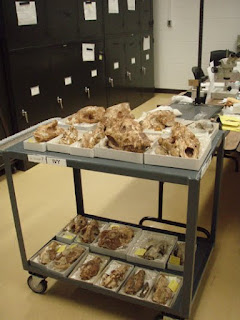18 December 2009. New York, NY
The day began rather cold, around -12 C. I got to the museum by 0840, to look over the remaining exhibits that I have not visited. I began working promptly at 0930, unpeeling the borophagine molds I made the day before.

[exhibits: a west coast Native American boat stretching the length of the south entrance foyer]

[Friday morning cleaning of the elephants by exhibits staff, quite a sight to see the immense size of these mammals with a human scale]
After the borophagine molds are all done, I picked another batch of teeth to clean. I turned my attention to hyaenids, which will take longer to clean for the thick glue present on most specimens.

[a cast of the holotype of "Peking Man"
Homo erectus, part of the batch of specimens lost in World War II during the evacuation of important scientific specimens from Beijing to the U.S.]

[the only reconstruction of the "Peking Man" locality of Zhoukoudian I have seen with a model and painting of the giant hyena
Pachycrocuta brevirostris stalking the hominine
Homo erectus]
By 1300 (more than three hours later), I finally finished cleaning the hyaenid teeth. While waiting for the second-round molds to set, I went upstairs to pack my tools into a box to mail back to LACM, so that on the way back I can carry everything else directly onboard, without worrying about losing my baggage (again).
1530. I am done with everything I set out to accomplish in New York on this trip. I cleaned up my work area, and went downstairs to see the three special exhibits (frogs, extreme mammals, and the Silk road). I bought a
Dunkleosteus toy for my fiancee, and a wooden carved camel for myself.

[exhibits: a skull of the giant archaic mesonychid
Andrewsarchus mongoliensis on display in the extreme mammals special exhibit; it's the length of my leg!]

[exhibits: a model of the giant perissodactyl
Indricotherium stands in front of the entrance to the extreme mammals special exhibit. The animal stood around 18 feet at the shoulder]
I went up to Dr. Ni's office before the museum closed, and sat down to do some last-minute microscope photographs of enamel microstructure on his fancy microscope system. I photographed a few teeth of
Osbornodon renjiei (a hesperocyonine dog named by now LACM curator Dr. Xiaoming Wang), and called it done.
Dr. Ni rode the subway with me until I had to get off at 103rd Street. We bid farewell, and promised our next meeting in Beijing (he is returning to Beijing in February for several months to do research, and will probably overlap with our 2010 field season in China).

[the subway station gateway to the American Museum of Natural History at 81st Street]
from my field notes on the last night in New York:
"This trip has been very productive overall, but my stay in the hostel was a lot less than pleasant; the data collected should allow a preliminary conclusion to be made from my dissertation research, while pointing to areas that will require additional data collection to improve."
My flight for Edmonton is (so far) on time for departure, connecting in Toronto mid-day tomorrow. A snowstorm is headed for New York from the south, and I cross my fingers hoping to escape another round of chaos!

[waiting to leave NYC at New York JFK International Airport]
Live from New York City, it's Jack with another research trip!





































